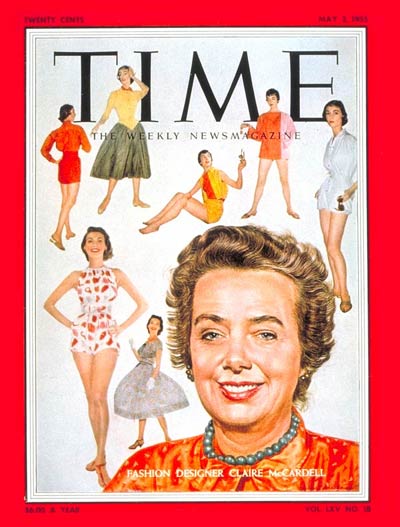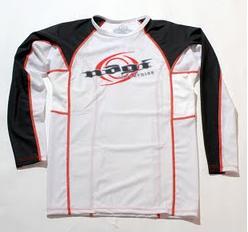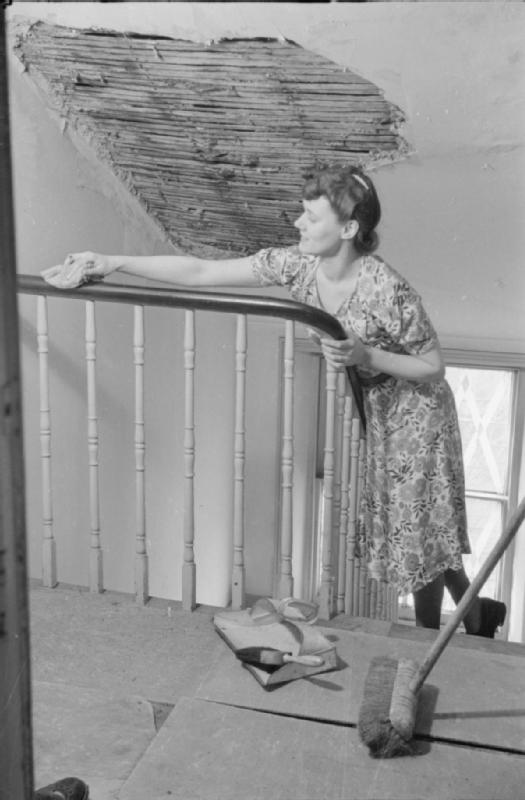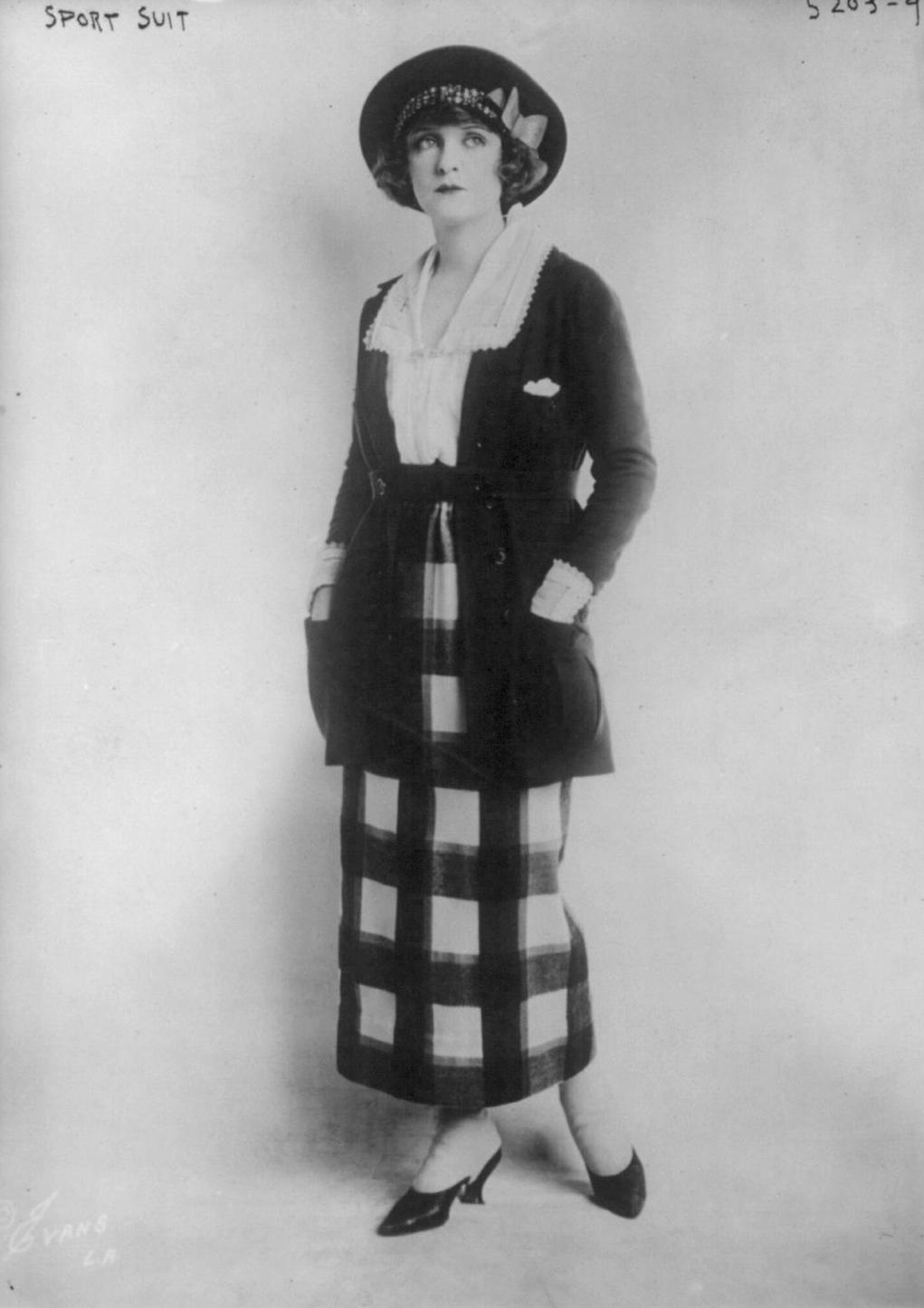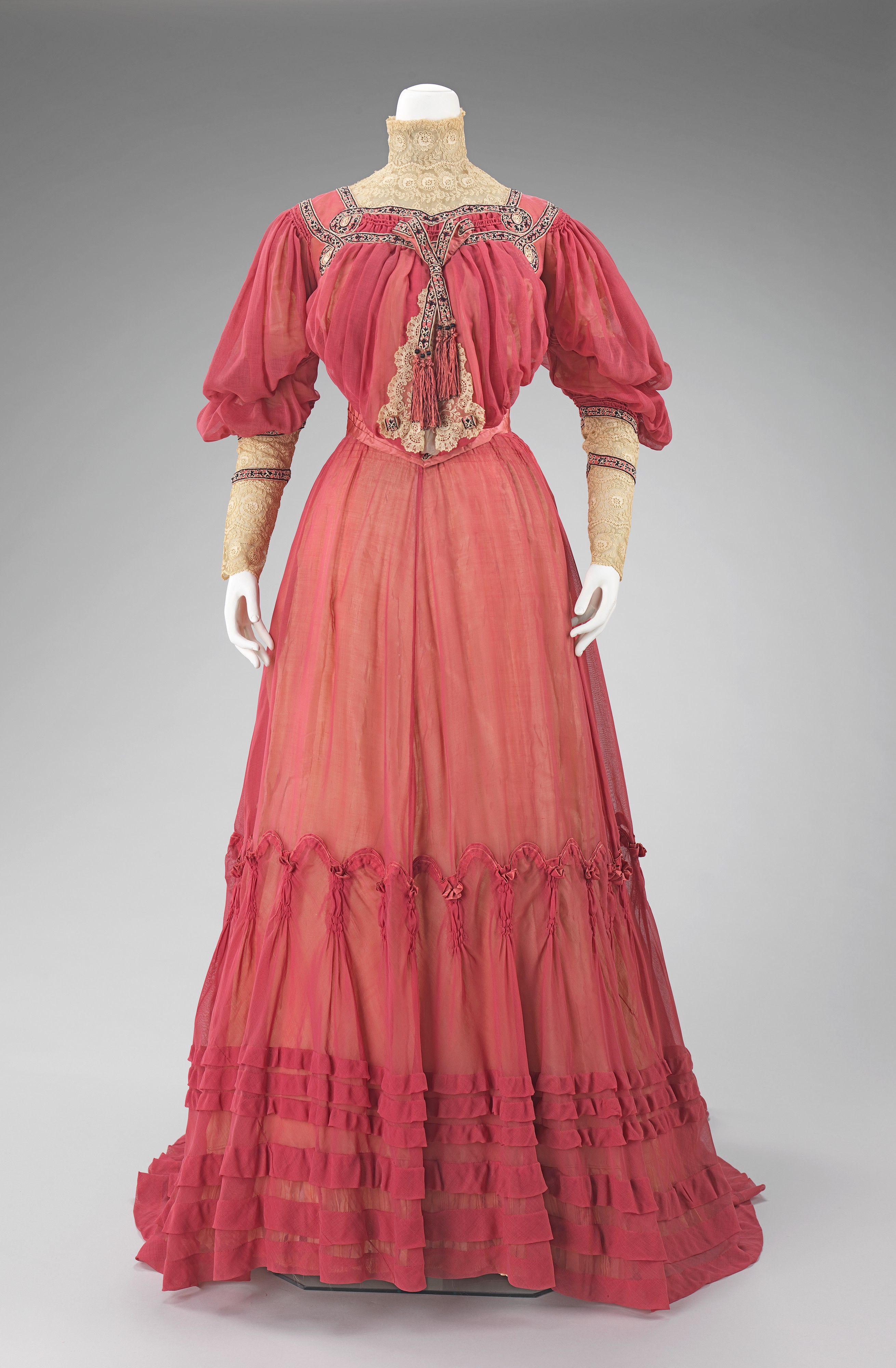|
Popover (dress)
Popover is a type of dress originally designed by Claire McCardell in 1942. The outfit type became the basis for a variety of wrap-around dresses. A versatile wrap dress, it could be used as a bathing suit cover-up, house dress, dressing gown A dressing gown, housecoat or morning gown is a robe, a loose-fitting outer garment, worn by either men or women. They are similar to a bathrobe but without the absorbent material. A dressing gown or a housecoat is a loose, open-fronted gown ..., or party dress."Claire McCardell: "Popover" dress (C.I.45.71.2ab) , Heilbrunn Timeline of Art History" The Metropolitan Museum of Art. Web. 14 Nov 2009. It is iconic of the American Look and could be worn to entertain, to a party, or to cover up a swimsuit. References Further readingWorks of artMET Museum for an example of the dress.The 1940sby Robert Sickels pages 88, 238The Little Black Dress and Zoot Suits Depression and Wartime Fashions by Alison Behnke pages 45, 54 {{Fashion-stub ... [...More Info...] [...Related Items...] OR: [Wikipedia] [Google] [Baidu] |
Claire McCardell
Claire McCardell (May 24, 1905 – March 22, 1958) was an American fashion designer of ready-to-wear clothing in the twentieth century. She is credited with the creation of American sportswear. Early life McCardell was the eldest of four children born to Eleanor and Adrian McCardell in Frederick, Maryland. Adrian was a Maryland state senator and president of the Frederick County National Bank. As a child, McCardell earned the nickname "Kick" for her ability to keep the boys from pushing her around. Fascinated by fashion from a young age, McCardell wanted to move to New York City to study fashion design at age 16. Unwilling to send a teenager so far away, McCardell's father convinced her to enroll in the home economics program at Hood College instead. After two years of study in Maryland, McCardell moved to New York and enrolled in Parsons (then known as the New York School of Fine and Applied Art). In 1927, McCardell went to Paris, continuing her studies at the Parsons branch s ... [...More Info...] [...Related Items...] OR: [Wikipedia] [Google] [Baidu] |
Wrap Dress
A dress (also known as a frock or a gown) is a garment traditionally worn by women or girls consisting of a skirt with an attached bodice (or a matching bodice giving the effect of a one-piece garment). It consists of a top piece that covers the torso and hangs down over the legs. A dress can be any one-piece garment containing a skirt of any length, and can be formal or casual. A dress can have sleeves, straps, or be held up with elastic around the chest, leaving the shoulders bare. Dresses also vary in color. The hemlines of dresses vary depending on modesty, weather, fashion or the personal taste of the wearer. Overview Dresses are outer garments made up of a bodice and a skirt and can be made in one or more pieces. Dresses are generally suitable for both formal wear and casual wear in the West for women and girls. Historically, dresses could also include other items of clothing such as corsets, kirtles, partlets, petticoats, smocks, and stomachers. History 11th c ... [...More Info...] [...Related Items...] OR: [Wikipedia] [Google] [Baidu] |
Bathing Suit
A swimsuit is an item of clothing designed to be worn by people engaging in a water-based activity or water sports, such as swimming, diving and surfing, or sun-orientated activities, such as sun bathing. Different types may be worn by men, women, and children. A swimsuit can be described by various names, some of which are used only in particular locations, including swimwear, bathing suit, swimming costume, bathing costume, swimming suit, swimmers, swimming togs, bathers, cossie (short for "costume"), or swimming trunks for men, besides others. A swimsuit can be worn as an undergarment in sports that require a wetsuit such as water skiing, scuba diving, surfing, and wakeboarding. Swimsuits may also be worn to display the wearer's physical attributes, as in the case of beauty pageants or bodybuilding contests, and glamour photography and magazines like the annual ''Sports Illustrated Swimsuit Issue'' featuring models and sports personalities in swimsuits. There is a very wi ... [...More Info...] [...Related Items...] OR: [Wikipedia] [Google] [Baidu] |
House Dress
A house dress is a type of simple dress worn informally at home for household chores or for quick errands. The term originated in the late nineteenth century to describe at-home garments designed for maximum practicality and usually made from washable fabrics. It is directly descended from the Mother Hubbard dress. House dresses are also known as dusters in American and Philippine English, a term which also encompasses the muumuu. Such dresses were a necessary part of the housewife's wardrobe in the early twentieth century and could be widely purchased through mail-order catalogues. The house dress remains a contemporary and frequently worn garment in some parts of the world. Although an informal garment, the house dress, particularly during the 1950s, was intended to be stylish and feminine as well as serviceable. The concept of attractive house dresses was popularised in the late 1910s by Nell Donnelly Reed, whose "Nelly Don" housedresses (manufactured by The Donnelly Garment ... [...More Info...] [...Related Items...] OR: [Wikipedia] [Google] [Baidu] |
Dressing Gown
A dressing gown, housecoat or morning gown is a robe, a loose-fitting outer garment, worn by either men or women. They are similar to a bathrobe but without the absorbent material. A dressing gown or a housecoat is a loose, open-fronted gown closed with a fabric belt that is put on over nightwear on rising from bed, or, less commonly today, worn over some day clothes when partially dressed or undressed in the morning or evening (for example, over a man's shirt and trousers without jacket and tie). Dressing gowns are typically worn around the house. They may be worn for warmth, as a convenient covering over nightwear when not being in bed, or as a form of lingerie. A dressing gown may be worn over nightwear or other clothing, or with nothing underneath. When guests or other visitors are expected to enter the household while the host(s) are partially dressed or undressed, the hosts may put on additional clothing, such as a dressing gown. History The regular wearing of a dressi ... [...More Info...] [...Related Items...] OR: [Wikipedia] [Google] [Baidu] |
Party Dress
A dress (also known as a frock or a gown) is a garment traditionally worn by women or girls consisting of a skirt with an attached bodice (or a matching bodice giving the effect of a one-piece garment). It consists of a top piece that covers the torso and hangs down over the legs. A dress can be any one-piece garment containing a skirt of any length, and can be formal or casual. A dress can have sleeves, straps, or be held up with elastic around the chest, leaving the shoulders bare. Dresses also vary in color. The hemlines of dresses vary depending on modesty, weather, fashion or the personal taste of the wearer. Overview Dresses are outer garments made up of a bodice and a skirt and can be made in one or more pieces. Dresses are generally suitable for both formal wear and casual wear in the West for women and girls. Historically, dresses could also include other items of clothing such as corsets, kirtles, partlets, petticoats, smocks, and stomachers. History 11t ... [...More Info...] [...Related Items...] OR: [Wikipedia] [Google] [Baidu] |
American Look (fashion Movement)
Sportswear is an American fashion term originally used to describe separates, but which since the 1930s has come to be applied to day and evening fashions of varying degrees of formality that demonstrate a specific relaxed approach to their design, while remaining appropriate for a wide range of social occasions. The term is not necessarily synonymous with activewear, clothing designed specifically for participants in sporting pursuits. Although sports clothing was available from European haute couture houses and "sporty" garments were increasingly worn as everyday or informal wear, the early American sportswear designers were associated with ready-to-wear manufacturers. While most fashions in America in the early 20th century were directly copied from, or influenced heavily by Paris, American sportswear became a home-grown exception to this rule, and could be described as the American Look. Sportswear was designed to be easy to look after, with accessible fastenings that enabled a ... [...More Info...] [...Related Items...] OR: [Wikipedia] [Google] [Baidu] |
1940s Fashion
Year 194 ( CXCIV) was a common year starting on Tuesday (link will display the full calendar) of the Julian calendar. At the time, it was known as the Year of the Consulship of Septimius and Septimius (or, less frequently, year 947 '' Ab urbe condita''). The denomination 194 for this year has been used since the early medieval period, when the Anno Domini calendar era became the prevalent method in Europe for naming years. Events By place Roman Empire * Emperor Septimius Severus and Decimus Clodius Septimius Albinus Caesar become Roman Consuls. * Battle of Issus: Septimius Severus marches with his army (12 legions) to Cilicia, and defeats Pescennius Niger, Roman governor of Syria. Pescennius retreats to Antioch, and is executed by Severus' troops. * Septimius Severus besieges Byzantium (194–196); the city walls suffer extensive damage. Asia * Battle of Yan Province: Warlords Cao Cao and Lü Bu fight for control over Yan Province; the battle lasts for over 1 ... [...More Info...] [...Related Items...] OR: [Wikipedia] [Google] [Baidu] |
1942 Clothing
Year 194 ( CXCIV) was a common year starting on Tuesday (link will display the full calendar) of the Julian calendar. At the time, it was known as the Year of the Consulship of Septimius and Septimius (or, less frequently, year 947 ''Ab urbe condita''). The denomination 194 for this year has been used since the early medieval period, when the Anno Domini calendar era became the prevalent method in Europe for naming years. Events By place Roman Empire * Emperor Septimius Severus and Decimus Clodius Septimius Albinus Caesar become Roman Consuls. * Battle of Issus: Septimius Severus marches with his army (12 legions) to Cilicia, and defeats Pescennius Niger, Roman governor of Syria. Pescennius retreats to Antioch, and is executed by Severus' troops. * Septimius Severus besieges Byzantium (194–196); the city walls suffer extensive damage. Asia * Battle of Yan Province: Warlords Cao Cao and Lü Bu fight for control over Yan Province; the battle lasts for over 100 days ... [...More Info...] [...Related Items...] OR: [Wikipedia] [Google] [Baidu] |
Dresses
A dress (also known as a frock or a gown) is a garment traditionally worn by women or girls consisting of a skirt with an attached bodice (or a matching bodice giving the effect of a one-piece garment). It consists of a top piece that covers the torso and hangs down over the legs. A dress can be any one-piece garment containing a skirt of any length, and can be formal or casual. A dress can have sleeves, straps, or be held up with elastic around the chest, leaving the shoulders bare. Dresses also vary in color. The hemlines of dresses vary depending on modesty, weather, fashion or the personal taste of the wearer. Overview Dresses are outer garments made up of a bodice and a skirt and can be made in one or more pieces. Dresses are generally suitable for both formal wear and casual wear in the West for women and girls. Historically, dresses could also include other items of clothing such as corsets, kirtles, partlets, petticoats, smocks, and stomachers. History 11t ... [...More Info...] [...Related Items...] OR: [Wikipedia] [Google] [Baidu] |
